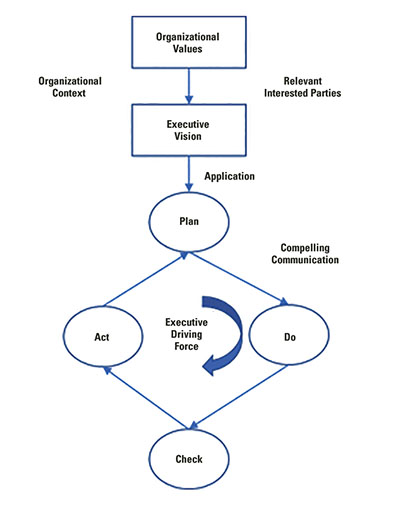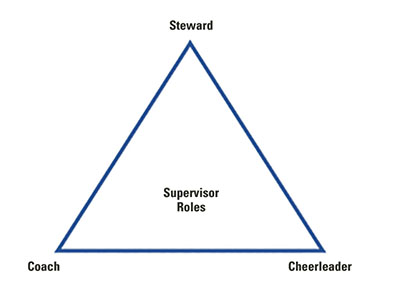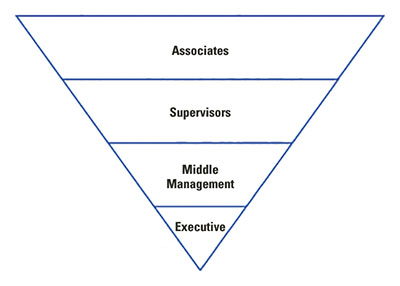Process-Driving Executive Behaviors
Top management support is the most commonly cited factor in the success of safety programs in the literature of the safety professional. The lack of such support is also cited as a frequent reason for poor safety performance in manufacturing plants. Unfortunately, in many cases the specific expectations of management and the definition of the needed support are seldom articulated. Just what is it that executive managers need to do to foster excellent safety performance?
Executives have responsibility for the establishment of a working system to identify and reduce safety risk within the organization. This safety management system may take various forms, such as formal third-party certification to ISO 45001, behavior-based or people-based systems, and many other variants. Successful systems use closed-loop communication systems based on the Plan-Do-Check-Act (PDCA) model, allowing for continual improvement and adaptation to changing conditions and circumstances.
Executive action can be divided into two broad categories: those actions that drive the process (which in turn creates the conditions of safe work) and those actions that communicate organizational values, which form the rationale behind both the process and individual decision-making at every level.
Process-Driving Behaviors
Executive action necessary to energize and maintain a safety management system can best be described in the diagram shown in Figure 1. This set of relationships derive from formal research and the management principles found in ISO 9000:2015. The result of the PDCA feedback loop in the diagram is a reduction in risk due to safety hazards, an increase in conformity to procedures and expected behaviors, and a reduction in the rate of occupational injuries.

Figure 2 begins with the organizational values that are adopted by the company and affirmed by the executive responsible for the firm. These values should align with a basic safety message consistent with the overwhelming priority of human life.
Often, the organization is created with the values of the founder at the center; the executive then is often called to bring the company back to its roots. Whatever the scenario, the executive brings with him his own set of value propositions that he holds to be true and to which he (consciously or not) will return. Over time, groups tend to mirror their leader and value what he values. Thoughtful executives will make time to reflect on the worthiness of their values in order to more deliberately inculcate them in others. This is the first of five leadership practices espoused by Kouzes and Posner in their understanding of transformational leadership.

Values clarification leads to a desire to improve the situation around the executive. Gaps between the way things are and the way they could be—if the values grasped by the executive are commonplace and lived—are seen. Opportunity is identified, and an image of a new reality begins to emerge. This image becomes settled in the mind of the executive, and a clarified vision of a new reality related to the organization emerges.
This new vision is influenced by the existing constraints, strengths, weaknesses, opportunities, and threats inherent in the organization’s context. The executive must begin where (s)he is, regardless of how different the desired new reality might be.
This new vision is also tempered by the influence of those relevant, interested parties who have the right or authority to speak into the organization or to direct its activity in some way. These parties might include, among others, customers, key suppliers, and corporate overseers.
As the vision is strengthened by exposure to these influences, it is communicated to the next layer of management who share in the implementation of the vision. This is accomplished through planning.
Planning
Executives lead planning sessions that will set the course for the implementation of the vision. It is abdicating responsibility and showing inadequate commitment to talk about what is needed but let others “work out the details.” The safety officer and key management staff must be involved by executive presence; authorization and guidance are critical. The next layer of management needs to understand, as personally and passionately as possible, just what this vision will look like when it is fleshed out in tangible changes in organization, structure, processes, and responsibilities.
Communication is central to the success of this endeavor, and the executive’s “stamp” needs to be on it and in it for success.
The goal of planning together is to establish the apparatus for the feedback loop that encompasses the PDCA cycle. This will be created (or reinforced) through a specific timeline of changes, including the needed training and rollout of new organization and other documented changes. In the crucible of forming this initial plan, a more concrete understanding of the vision in its details will take place––and buy-in will be enhanced since they had a hand in creating the system.
Unfortunately, many safety managers develop a system on their own, with a sign-off of the package at the end. This approach inadequately engages executive management and builds little ownership and little understanding of what the system requires and what it intends to accomplish. As a consequence, when such systems fail, the system or the paperwork are blamed for poor results, not the lack of planning investment from executive management.
Turning the Wheel
Having invested in the establishment of a company safety management structure and processes, the executive is then responsible for continuously putting energy into the “wheel” so the PDCA loop rotates, causing learning, improvement, and risk reduction to take place.
How do executives energize the system?
First, as noted in Figure 1, compelling communication needs to reach every associate in the business. The vision needs to be cast, and the executives must be observed to personally be throwing their weight of authority and conviction behind the safety initiative. Past performance, obstacles, and other realities must be acknowledged, but the emphasis must be on the new day and the new place to which the effort will take the group.
This cannot be seen as simply a new program or a project. The culture of the company must change, and that needs to be communicated, along with the admission by the executive that things have not been what they should be. A good coach accepts the responsibility for the loss, and personally commits to prepare the team for what is next.
In this brand of communication, authenticity—born from the strength of conviction in the value of human life and its primacy over every other business goal—is felt and the hearers are alerted to something noteworthy and hopeful. If authenticity is not felt, if this is just public relations with the troops or a cameo in the safety guy’s presentation, the results will be poor.
Second, continuing interest and genuine concern for progress at every level of the program needs to be in evidence. This can be accomplished through the executive’s deliberate and random intersection with the program activities and people. This might include showing up at meetings (unannounced), talking to associates on the floor about how things are going, and interacting with audits and plant “walk-arounds.”
There are good and bad ways to do this. Executives do not take over the activity; they observe politely and reserve critique for a private discussion. The executive is not present to micro-manage but to authorize and underscore the work the team is doing to promote safety. The executive is present to understand the issues first-hand, to express appreciation, and to offer resources where they might be needed to support the work.
Executives can support by asking the right questions, questions that demonstrate a priority on the humans. In a review of an injury for the purpose of root cause analysis, if the only question the executive asks is, “So how much is this going to cost?” the executive should stay in his office. But if the executive asks about the injured person and how their family is doing, or asks, “What can I do to help?” then (s)he has strengthened the value of safety and encouraged and energized the work.
Third, executives need to preside over formal, periodic reviews of the progress of the safety system and its results. Results metrics should be a combination of leading and lagging indicators. The outcome from such meetings is not simply to “rubber stamp” results but to determine if the plan is on target and either celebrate the results or identify actions to be taken to address shortfalls. Action items that arise from such meetings should be picked up first thing the following meeting. Compelling presenters to personally deliver (and explain) results should provide a measure of accountability and ownership. The executive questions asked in this review meeting are also indicative of their interest and commitment to the process. The opening and final words of such a meeting should be from the executive: a platform to put the leader’s interpretation on the work, on the effort as a whole, and the company values this work is intended to build.
Fourth, executives need to be vigilant and aware of rebellion and naysayers. Some within the company, whether in middle management or supervision, may not share the vision and values of the leader. This makes such people not merely ineffective at moving the effort forward; it poisons the work and calls into question whether the executive is truly committed to the vision––or to merely not rocking the boat? Executives cannot abide those who are not aligned with the vision and values of the company. These are core beliefs and the marching orders from the top; insubordination cannot be tolerated.
Now, others in the organization may be committed to the vision and adhere to the values but disagree with methods or procedures or some other aspect of the planning and implementation of the work. Provided these individuals express “loyal opposition” and speak in the right forum and with a degree of respect, executives should recognize and listen to these contrarians. The team cannot make the best plans without hearing alternatives. Conflict is important to get out on the table, and understanding multiple perspectives allows an approach that respects the risks and downsides. Interpersonally, disagreements should be aired early and often so people feel heard and don’t store up bitterness. Good executives might recruit contrarians to sit in on planning meetings for just these purposes if they don’t already have a few.
This vigilance is carried out most effectively by the executive often asking, “How are we doing?” and listening to the answers. This should be done in a setting where the person asked has the freedom to say, “I think we’re making a mistake about …” or perhaps, “I think you are wrong about ….” The courage of a subordinate to tell the executive (s)he is wrong should be reason enough to respect the perspective and thank the person for bringing it up. Where the executive can keep from being defensive and actually hear what the person is trying to say, learning can take place.
Finally, in all that executives do, they must express positive feedback and appreciation for those doing the work, but especially to direct subordinates who carry the burden of translating their expectations into reality. The support they give to direct reports can then be shared with others down the line.
Value-Communicating Behaviors
The executive’s role in the organization should be expressed as in Figure 3. In an organization committed to the primacy of human life, executives become servants, because their relationship to the human life around them is to nurture and protect it, even as they send the workers out to accomplish their production activities.
In Figure 3, the executive provides support through middle managers that report to him. The priority is to support these direct reports so they are enabled, equipped, and empowered to support the next layer.

In such an organization, everyone serves a support role for the front-line associates, the people at the “top” of the organization. This inversion from the typical way a pyramidal hierarchy is displayed reflects an important recognition: The only ones in the company making anything that can be sold are the associates on the shop floor. Their needs are paramount to the organization, and protecting their safety and security is informed self-interest if nothing else. This suggests some strategies for executives to drive their values into the organization “top up” as it were.
The primary focus of executives, then, is the reproduction of themselves in the lives of their direct reports, the next chain of command. This will require significant investment of time to encourage, correct, direct, and monitor their performance and especially decision-making. This must be done while keeping a largely “hands off” approach, as the intent is to see what these subordinates do on their own not on how well they can copy the boss or follow explicit instructions from above. MC
This article is based on the paper, “Executive Safety Responsibility” (2022-025), that will be presented on April 25 at CastExpo 2022 in Columbus, Ohio. To register to attend, visit www.castexpo.com.